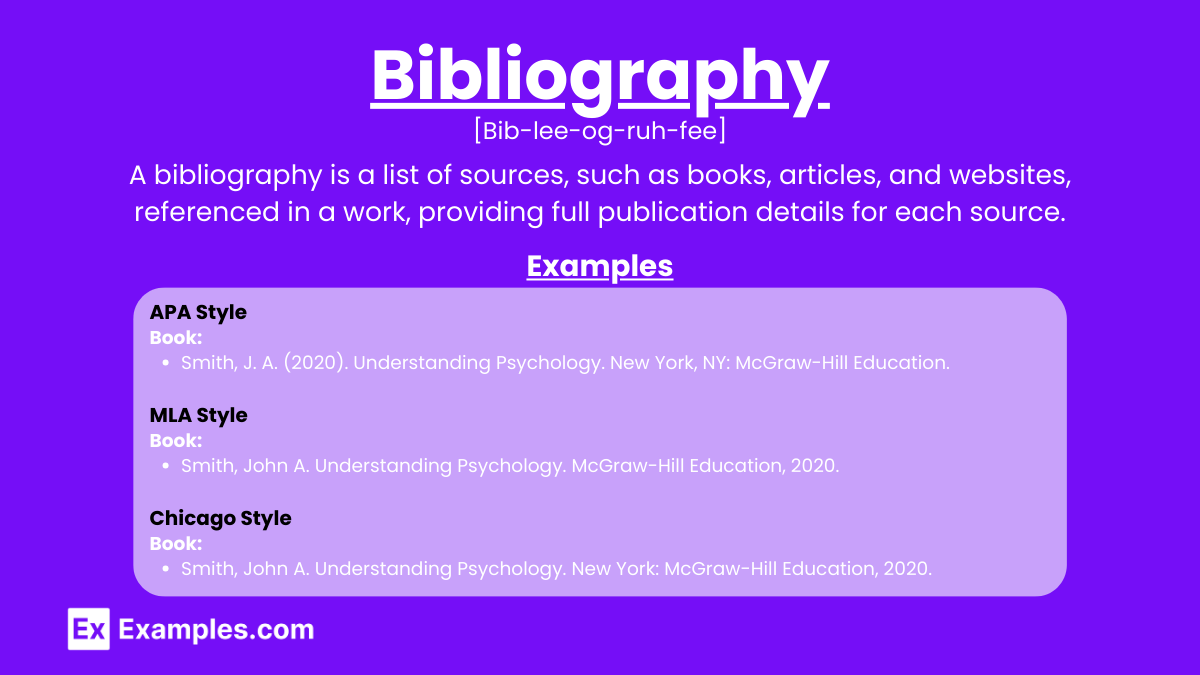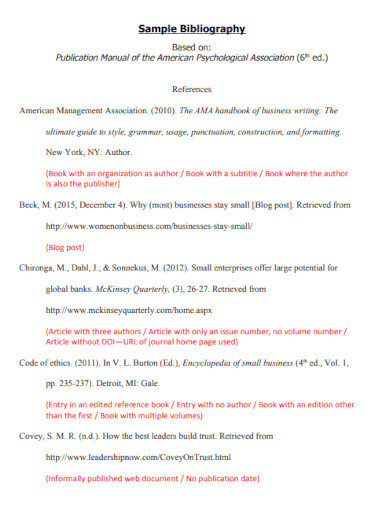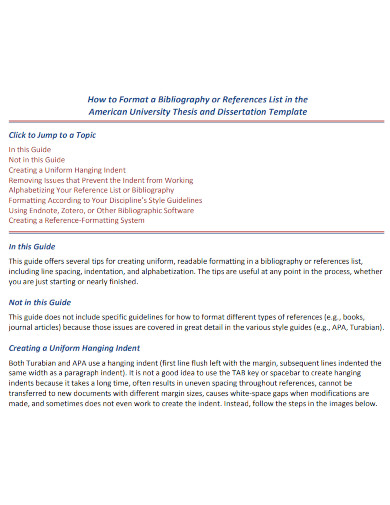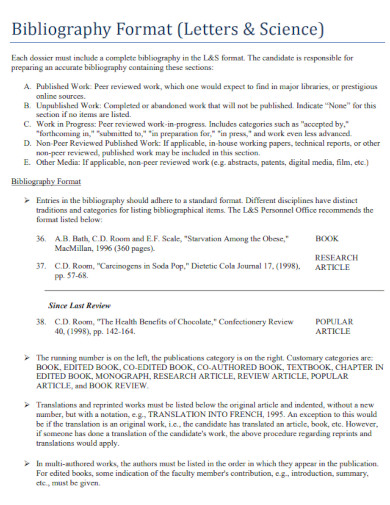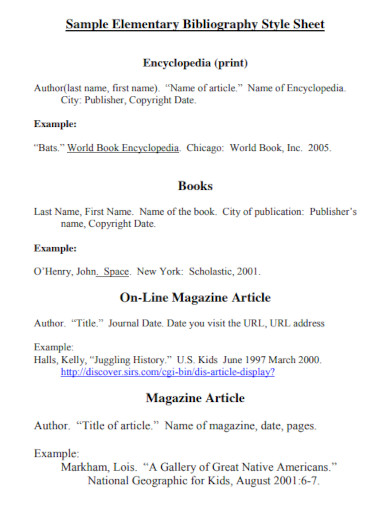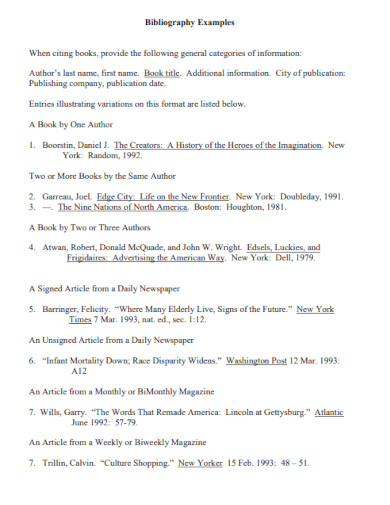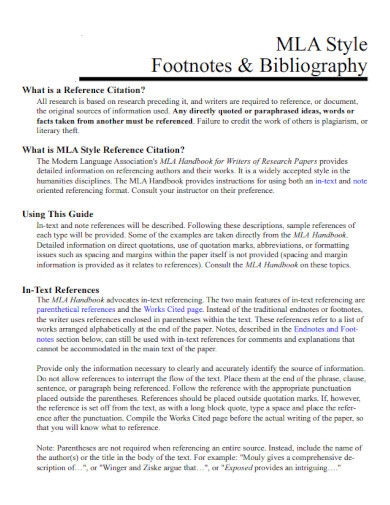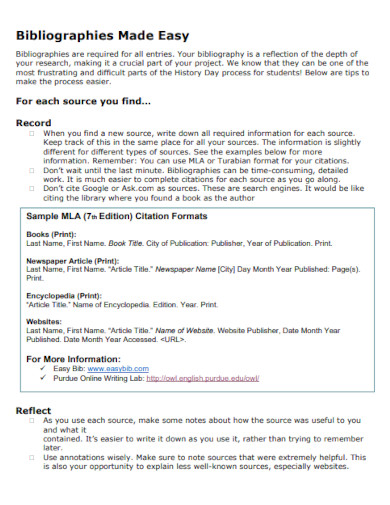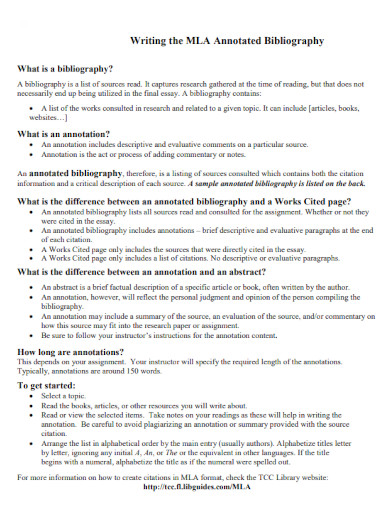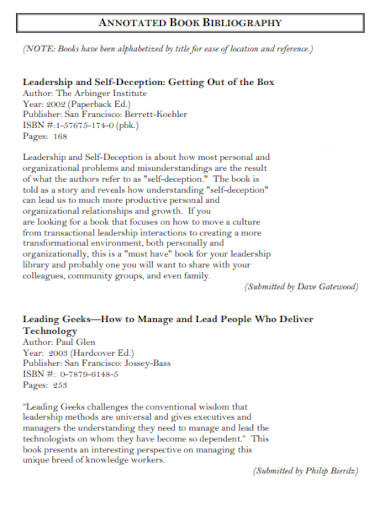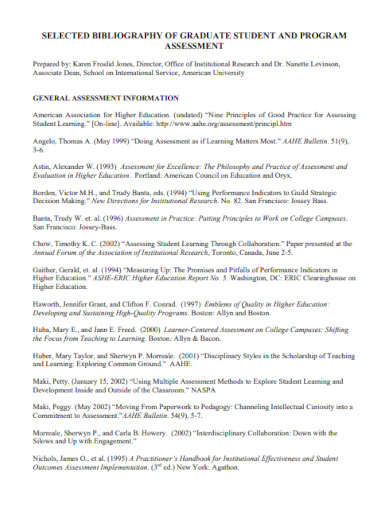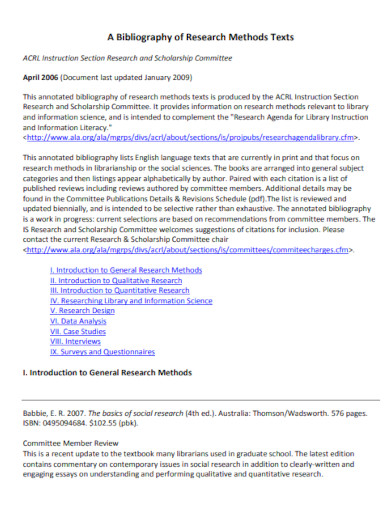85+ Bibliography Examples
Writing a research paper or a thesis, you may encounter some references or some links below or at the very end of the page. We call these annotated bibliographies, or just bibliographies.
What Is a Bibliography?
A bibliography is a list of information that is usually found below the pages or at the end of the pages of a book, a research paper, a thesis paper, or even a report. The bibliography as the term itself is another word for listing your sources.
Bibliography Formats
Creating a bibliography is essential for any academic work to credit sources used. The format varies based on the citation style. Below are examples for the most common styles: APA, MLA, and Chicago.
1. APA (American Psychological Association) Style
Books: Author(s). (Year). Title of the book. Publisher.
Example: Smith, J. (2020). Understanding English Literature. Penguin Books.
Articles: Author(s). (Year). Title of the article. Title of the Journal, Volume(Issue), Page numbers. DOI
Example: Doe, J. (2019). The impact of modern technology on literature. Literary Review, 34(2), 145-158. https://doi.org/10.1234/lr.2019.02.015
2. MLA (Modern Language Association) Style
Books: Author(s). Title of the book. Publisher, Year.
Example: Smith, John. Understanding English Literature. Penguin Books, 2020.
Articles: Author(s). “Title of the article.” Title of the Journal, vol. Volume, no. Issue, Year, pp. Page numbers.
Example: Doe, Jane. “The Impact of Modern Technology on Literature.” Literary Review, vol. 34, no. 2, 2019, pp. 145-158.
3. Chicago Style
Books: Author(s). Title of the book. Place of publication: Publisher, Year.
Example: Smith, John. Understanding English Literature. New York: Penguin Books, 2020.
Articles: Author(s). “Title of the article.” Title of the Journal Volume, no. Issue (Year): Page numbers. DOI
Example: Doe, Jane. “The Impact of Modern Technology on Literature.” Literary Review 34, no. 2 (2019): 145-158. https://doi.org/10.1234/lr.2019.02.015
Examples of Bibliography for Students
APA Style
- Book:
- Doe, J. (2021). Understanding Climate Change. Environmental Press.
- Journal Article:
- Smith, L. M. (2020). The impact of social media on adolescent mental health. Journal of Youth Studies, 35(2), 145-160.
- Website:
- Johnson, R. (2019, October 10). The history of the internet. Tech Times. https://www.techtimes.com/history-internet
- Chapter in an Edited Book:
- Brown, A. (2018). Renewable energy sources. In T. Green (Ed.), Advances in Environmental Science (pp. 50-75). Nature Publishing.
- Conference Paper:
- White, P. (2017). AI advancements in healthcare. In S. Lewis (Ed.), Proceedings of the International Conference on Health Informatics (pp. 102-110). HealthTech.
MLA Style
- Book:
- Doe, Jane. Understanding Climate Change. Environmental Press, 2021.
- Journal Article:
- Smith, Lisa M. “The Impact of Social Media on Adolescent Mental Health.” Journal of Youth Studies, vol. 35, no. 2, 2020, pp. 145-160.
- Website:
- Johnson, Robert. “The History of the Internet.” Tech Times, 10 Oct. 2019, https://www.techtimes.com/history-internet.
- Chapter in an Edited Book:
- Brown, Alice. “Renewable Energy Sources.” Advances in Environmental Science, edited by Thomas Green, Nature Publishing, 2018, pp. 50-75.
- Conference Paper:
- White, Peter. “AI Advancements in Healthcare.” Proceedings of the International Conference on Health Informatics, edited by Sarah Lewis, HealthTech, 2017, pp. 102-110.
Chicago Style
- Book:
- Doe, Jane. Understanding Climate Change. Environmental Press, 2021.
- Journal Article:
- Smith, Lisa M. “The Impact of Social Media on Adolescent Mental Health.” Journal of Youth Studies 35, no. 2 (2020): 145-160.
- Website:
- Johnson, Robert. “The History of the Internet.” Tech Times. Last modified October 10, 2019. https://www.techtimes.com/history-internet.
- Chapter in an Edited Book:
- Brown, Alice. “Renewable Energy Sources.” In Advances in Environmental Science, edited by Thomas Green, 50-75. Nature Publishing, 2018.
- Conference Paper:
- White, Peter. “AI Advancements in Healthcare.” In Proceedings of the International Conference on Health Informatics, edited by Sarah Lewis, 102-110. HealthTech, 2017.
Examples of Bibliography in Research
APA Style
- Book:
- Watson, G. H. (2022). Modern Geopolitics: Analyzing Global Trends. Global Press.
- Journal Article:
- Thompson, R. A., & Williams, D. J. (2021). The role of artificial intelligence in modern warfare. Defense Studies Journal, 28(4), 200-215.
- Website:
- Hernandez, M. (2020, December 5). The evolution of quantum computing. Quantum Today. https://www.quantumtoday.com/evolution-quantum-computing
- Chapter in an Edited Book:
- Cooper, L. (2019). Sustainable agriculture practices. In H. Brown (Ed.), Innovations in Agricultural Science (pp. 85-102). GreenField Publishers.
- Conference Paper:
- Jackson, E. (2018). Ethical implications of genetic engineering. In A. Patel (Ed.), Proceedings of the Bioethics Symposium (pp. 55-63). Bioethics Association.
MLA Style
- Book:
- Watson, George H. Modern Geopolitics: Analyzing Global Trends. Global Press, 2022.
- Journal Article:
- Thompson, Rachel A., and David J. Williams. “The Role of Artificial Intelligence in Modern Warfare.” Defense Studies Journal, vol. 28, no. 4, 2021, pp. 200-215.
- Website:
- Hernandez, Maria. “The Evolution of Quantum Computing.” Quantum Today, 5 Dec. 2020, https://www.quantumtoday.com/evolution-quantum-computing.
- Chapter in an Edited Book:
- Cooper, Lisa. “Sustainable Agriculture Practices.” Innovations in Agricultural Science, edited by Harold Brown, GreenField Publishers, 2019, pp. 85-102.
- Conference Paper:
- Jackson, Emily. “Ethical Implications of Genetic Engineering.” Proceedings of the Bioethics Symposium, edited by Amit Patel, Bioethics Association, 2018, pp. 55-63.
Chicago Style
- Book:
- Watson, George H. Modern Geopolitics: Analyzing Global Trends. Global Press, 2022.
- Journal Article:
- Thompson, Rachel A., and David J. Williams. “The Role of Artificial Intelligence in Modern Warfare.” Defense Studies Journal 28, no. 4 (2021): 200-215.
- Website:
- Hernandez, Maria. “The Evolution of Quantum Computing.” Quantum Today. Last modified December 5, 2020. https://www.quantumtoday.com/evolution-quantum-computing.
- Chapter in an Edited Book:
- Cooper, Lisa. “Sustainable Agriculture Practices.” In Innovations in Agricultural Science, edited by Harold Brown, 85-102. GreenField Publishers, 2019.
- Conference Paper:
- Jackson, Emily. “Ethical Implications of Genetic Engineering.” In Proceedings of the Bioethics Symposium, edited by Amit Patel, 55-63. Bioethics Association, 2018.
Examples of Bibliography for School Project
APA Style
- Book:
- Johnson, A. (2021). The Solar System Explained. Space Science Press.
- Journal Article:
- Patel, R. (2020). The effects of plastic pollution on marine life. Environmental Studies Journal, 34(1), 45-58.
- Website:
- Martin, L. (2019, September 15). The history of video games. Game World. https://www.gameworld.com/history-videogames
- Chapter in an Edited Book:
- Smith, J. (2018). The role of bees in pollination. In K. Thompson (Ed.), Insect Biology and Ecology (pp. 120-135). Nature Publishing.
- Online Newspaper Article:
- Nguyen, T. (2020, June 10). Innovative teaching methods in 21st-century classrooms. Education Today. https://www.educationtoday.com/innovative-teaching-methods
MLA Style
- Book:
- Johnson, Anne. The Solar System Explained. Space Science Press, 2021.
- Journal Article:
- Patel, Raj. “The Effects of Plastic Pollution on Marine Life.” Environmental Studies Journal, vol. 34, no. 1, 2020, pp. 45-58.
- Website:
- Martin, Lucy. “The History of Video Games.” Game World, 15 Sept. 2019, https://www.gameworld.com/history-videogames.
- Chapter in an Edited Book:
- Smith, John. “The Role of Bees in Pollination.” Insect Biology and Ecology, edited by Karen Thompson, Nature Publishing, 2018, pp. 120-135.
- Online Newspaper Article:
- Nguyen, Tran. “Innovative Teaching Methods in 21st-Century Classrooms.” Education Today, 10 June 2020, https://www.educationtoday.com/innovative-teaching-methods.
Chicago Style
- Book:
- Johnson, Anne. The Solar System Explained. Space Science Press, 2021.
- Journal Article:
- Patel, Raj. “The Effects of Plastic Pollution on Marine Life.” Environmental Studies Journal 34, no. 1 (2020): 45-58.
- Website:
- Martin, Lucy. “The History of Video Games.” Game World. Last modified September 15, 2019. https://www.gameworld.com/history-videogames.
- Chapter in an Edited Book:
- Smith, John. “The Role of Bees in Pollination.” In Insect Biology and Ecology, edited by Karen Thompson, 120-135. Nature Publishing, 2018.
- Online Newspaper Article:
- Nguyen, Tran. “Innovative Teaching Methods in 21st-Century Classrooms.” Education Today, June 10, 2020. https://www.educationtoday.com/innovative-teaching-methods.
Examples of Bibliography for Books
APA Style
- Book by a Single Author:
- Carson, R. (1962). Silent Spring. Houghton Mifflin.
- Book by Multiple Authors:
- Diamond, J., & Ordunio, D. (1992). The Third Chimpanzee: The Evolution and Future of the Human Animal. HarperCollins.
- Edited Book:
- Marcus, G. E. (Ed.). (1995). Technoscientific Imaginaries: Conversations, Profiles, and Memoirs. University of Chicago Press.
- Book with an Edition:
- Turabian, K. L. (2013). A Manual for Writers of Research Papers, Theses, and Dissertations (8th ed.). University of Chicago Press.
- Book with a Volume:
- Sagan, C. (1980). Cosmos. Vol. 1. Random House.
MLA Style
- Book by a Single Author:
- Carson, Rachel. Silent Spring. Houghton Mifflin, 1962.
- Book by Multiple Authors:
- Diamond, Jared, and Douglas Ordunio. The Third Chimpanzee: The Evolution and Future of the Human Animal. HarperCollins, 1992.
- Edited Book:
- Marcus, George E., editor. Technoscientific Imaginaries: Conversations, Profiles, and Memoirs. University of Chicago Press, 1995.
- Book with an Edition:
- Turabian, Kate L. A Manual for Writers of Research Papers, Theses, and Dissertations. 8th ed., University of Chicago Press, 2013.
- Book with a Volume:
- Sagan, Carl. Cosmos. Vol. 1, Random House, 1980.
Chicago Style
- Book by a Single Author:
- Carson, Rachel. Silent Spring. Boston: Houghton Mifflin, 1962.
- Book by Multiple Authors:
- Diamond, Jared, and Douglas Ordunio. The Third Chimpanzee: The Evolution and Future of the Human Animal. New York: HarperCollins, 1992.
- Edited Book:
- Marcus, George E., ed. Technoscientific Imaginaries: Conversations, Profiles, and Memoirs. Chicago: University of Chicago Press, 1995.
- Book with an Edition:
- Turabian, Kate L. A Manual for Writers of Research Papers, Theses, and Dissertations. 8th ed. Chicago: University of Chicago Press, 2013.
- Book with a Volume:
- Sagan, Carl. Cosmos. Vol. 1. New York: Random House, 1980.
Examples of Bibliography for Websites
APA Style
- News Website:
- Walker, L. (2021, May 10). How climate change is affecting agriculture. Environmental News Today. https://www.environmentalnewstoday.com/climate-change-agriculture
- Educational Website:
- Johnson, M. (2020, July 22). The history of the Roman Empire. History for Kids. https://www.historyforkids.com/roman-empire
- Blog:
- Green, T. (2019, September 15). The future of renewable energy. EcoBlog. https://www.ecoblog.com/future-renewable-energy
- Organization Website:
- World Health Organization. (2020, November 30). COVID-19 updates. https://www.who.int/covid-19-updates
- Government Website:
- U.S. Census Bureau. (2021). U.S. and world population clock. https://www.census.gov/popclock
MLA Style
- News Website:
- Walker, Lisa. “How Climate Change Is Affecting Agriculture.” Environmental News Today, 10 May 2021, https://www.environmentalnewstoday.com/climate-change-agriculture.
- Educational Website:
- Johnson, Mary. “The History of the Roman Empire.” History for Kids, 22 July 2020, https://www.historyforkids.com/roman-empire.
- Blog:
- Green, Thomas. “The Future of Renewable Energy.” EcoBlog, 15 Sept. 2019, https://www.ecoblog.com/future-renewable-energy.
- Organization Website:
- World Health Organization. “COVID-19 Updates.” World Health Organization, 30 Nov. 2020, https://www.who.int/covid-19-updates.
- Government Website:
- U.S. Census Bureau. “U.S. and World Population Clock.” U.S. Census Bureau, 2021, https://www.census.gov/popclock.
Chicago Style
- News Website:
- Walker, Lisa. “How Climate Change Is Affecting Agriculture.” Environmental News Today. Last modified May 10, 2021. https://www.environmentalnewstoday.com/climate-change-agriculture.
- Educational Website:
- Johnson, Mary. “The History of the Roman Empire.” History for Kids. Last modified July 22, 2020. https://www.historyforkids.com/roman-empire.
- Blog:
- Green, Thomas. “The Future of Renewable Energy.” EcoBlog. Last modified September 15, 2019. https://www.ecoblog.com/future-renewable-energy.
- Organization Website:
- World Health Organization. “COVID-19 Updates.” World Health Organization. Last modified November 30, 2020. https://www.who.int/covid-19-updates.
- Government Website:
- U.S. Census Bureau. “U.S. and World Population Clock.” U.S. Census Bureau. Accessed 2021. https://www.census.gov/popclock.
Examples of Bibliography in APA Style
1. Book:
Single Author:
- Carson, R. (1962). Silent Spring. Houghton Mifflin.
Multiple Authors:
- Diamond, J., & Ordunio, D. (1992). The Third Chimpanzee: The Evolution and Future of the Human Animal. HarperCollins.
2. Journal Article:
Single Author:
- Smith, L. M. (2020). The impact of social media on adolescent mental health. Journal of Youth Studies, 35(2), 145-160.
Multiple Authors:
- Johnson, P. L., & Thompson, R. A. (2019). Advancements in renewable energy technologies. Journal of Environmental Science, 28(3), 210-225.
3. Website:
News Website:
- Walker, L. (2021, May 10). How climate change is affecting agriculture. Environmental News Today. https://www.environmentalnewstoday.com/climate-change-agriculture
Educational Website:
- Johnson, M. (2020, July 22). The history of the Roman Empire. History for Kids. https://www.historyforkids.com/roman-empire
4. Chapter in an Edited Book:
- Brown, A. (2018). Renewable energy sources. In T. Green (Ed.), Advances in Environmental Science (pp. 50-75). Nature Publishing.
5. Conference Paper:
- White, P. (2017). AI advancements in healthcare. In S. Lewis (Ed.), Proceedings of the International Conference on Health Informatics (pp. 102-110). HealthTech.
6. Online Newspaper Article:
- Black, S. (2020, July 15). New trends in education technology. The Education Times. https://www.edtimes.com/new-trends-edtech
7. E-book:
- Grey, T. (2019). Digital marketing strategies. E-Publishing Inc. https://www.epublishing.com/digital-marketing-strategies
8. Government Report:
- National Institute of Health. (2020). Annual report on mental health (NIH Publication No. 20-1234). https://www.nih.gov/mental-health-annual-report
9. Magazine Article:
- Hill, K. (2019, March). The rise of renewable energy. Energy Monthly, 48(3), 22-28.
10. Dissertation:
- Green, L. (2021). Exploring renewable energy policies in Europe (Doctoral dissertation). University of Environmental Studies.
More Examples & Samples of Bibliography in PDF
1. Bibliography Sample
2. Bibliography Format
3. Bibliography Format Example
4. Bibliography Style Sheet
5. Bibliography Examples PDF
6. MLA Style Bibliography
7. APA Annotated Bibliography
8. Bibliography Example in PDF
9. MLA Annotated Bibliography
10. Book Bibliography Example
11. Bibliography Examples for Students
12. Bibliography in Research
Purpose of a Bibliography
A bibliography serves several essential functions in academic and research work. Here are the primary purposes:
1. Crediting Sources
A bibliography acknowledges the work of other authors and researchers. It gives credit to those whose ideas, theories, and research have contributed to your work.
2. Avoiding Plagiarism
By properly citing sources, a bibliography helps you avoid plagiarism. Plagiarism is the unethical practice of using someone else’s work or ideas without proper acknowledgment.
3. Providing Evidence
A bibliography supports the claims and arguments made in your work. It shows that your research is based on credible sources and provides evidence to back up your points.
4. Guiding Further Research
A well-compiled bibliography can guide readers interested in exploring the topic further. It provides a list of resources that readers can use to expand their knowledge.
5. Demonstrating Research Effort
Including a comprehensive bibliography demonstrates the depth of your research. It shows that you have thoroughly investigated the topic and consulted a variety of sources.
6. Enhancing Credibility
A bibliography enhances the credibility of your work. It shows that you have engaged with existing research and literature, adding legitimacy to your findings and arguments.
7. Facilitating Verification
A bibliography allows others to verify the sources you used. This transparency helps maintain the integrity of academic and research work.
Rules of Bibliography
Creating a bibliography involves following specific rules to ensure accuracy, consistency, and clarity. Here are the essential rules for different citation styles:
1. General Rules
- Consistency: Use the same citation style throughout your bibliography.
- Alphabetical Order: List entries alphabetically by the author’s last name.
- Multiple Works by the Same Author: Arrange multiple works by the same author in chronological order, starting with the oldest.
- Author Names: Use the full name of authors (last name first), followed by their initials (for APA) or full first name (for MLA and Chicago).
- Titles: Italicize book and journal titles. Use quotation marks for article and chapter titles.
- Publication Details: Include all necessary publication details such as the publisher, year, volume, issue, and page numbers.
- Hanging Indent: Use a hanging indent for each entry, where the first line is flush left, and subsequent lines are indented.
2. APA Style Rules
- Books: Author(s). (Year). Title of the book. Publisher.
- Articles: Author(s). (Year). Title of the article. Title of the Journal, Volume(Issue), Page numbers. DOI
Example:
- Smith, J. (2020). Understanding English Literature. Penguin Books.
- Doe, J. (2019). The impact of modern technology on literature. Literary Review, 34(2), 145-158. https://doi.org/10.1234/lr.2019.02.015
3. MLA Style Rules
- Books: Author(s). Title of the book. Publisher, Year.
- Articles: Author(s). “Title of the article.” Title of the Journal, vol. Volume, no. Issue, Year, pp. Page numbers.
Example:
- Smith, John. Understanding English Literature. Penguin Books, 2020.
- Doe, Jane. “The Impact of Modern Technology on Literature.” Literary Review, vol. 34, no. 2, 2019, pp. 145-158.
4. Chicago Style Rules
- Books: Author(s). Title of the book. Place of publication: Publisher, Year.
- Articles: Author(s). “Title of the article.” Title of the Journal Volume, no. Issue (Year): Page numbers. DOI
Example:
- Smith, John. Understanding English Literature. New York: Penguin Books, 2020.
- Doe, Jane. “The Impact of Modern Technology on Literature.” Literary Review 34, no. 2 (2019): 145-158. https://doi.org/10.1234/lr.2019.02.015.
What is included in a Bibliography
A bibliography provides a comprehensive list of all the sources you have referred to or consulted in your research work. Here are the key elements included in a bibliography:
1. Author(s)
- Books: Full names of all authors. List them in the order they appear in the source.
- Articles: Full names of all authors. In APA, use initials for first and middle names; in MLA and Chicago, use full first names.
- Websites: Name of the author, if available. If not, use the name of the organization.
2. Title
- Books: Full title of the book, italicized.
- Articles: Title of the article in quotation marks. Title of the journal or magazine in italics.
- Websites: Title of the specific page or article in quotation marks. The website title in italics if different from the author or organization.
3. Publication Date
- Books: Year of publication.
- Articles: Year, and if available, the month and day.
- Websites: Date of publication or last update.
4. Publisher
- Books: Name of the publishing company.
- Websites: The organization responsible for publishing the content, if available.
5. Volume and Issue Numbers (for Articles)
- Journals: Include the volume number (italicized) and issue number (in parentheses).
6. Page Numbers (for Articles)
- Articles: The range of pages the article appears on.
7. DOI or URL
- Articles: Digital Object Identifier (DOI) for journal articles.
- Websites: The full URL of the webpage.
Bibliography vs. References
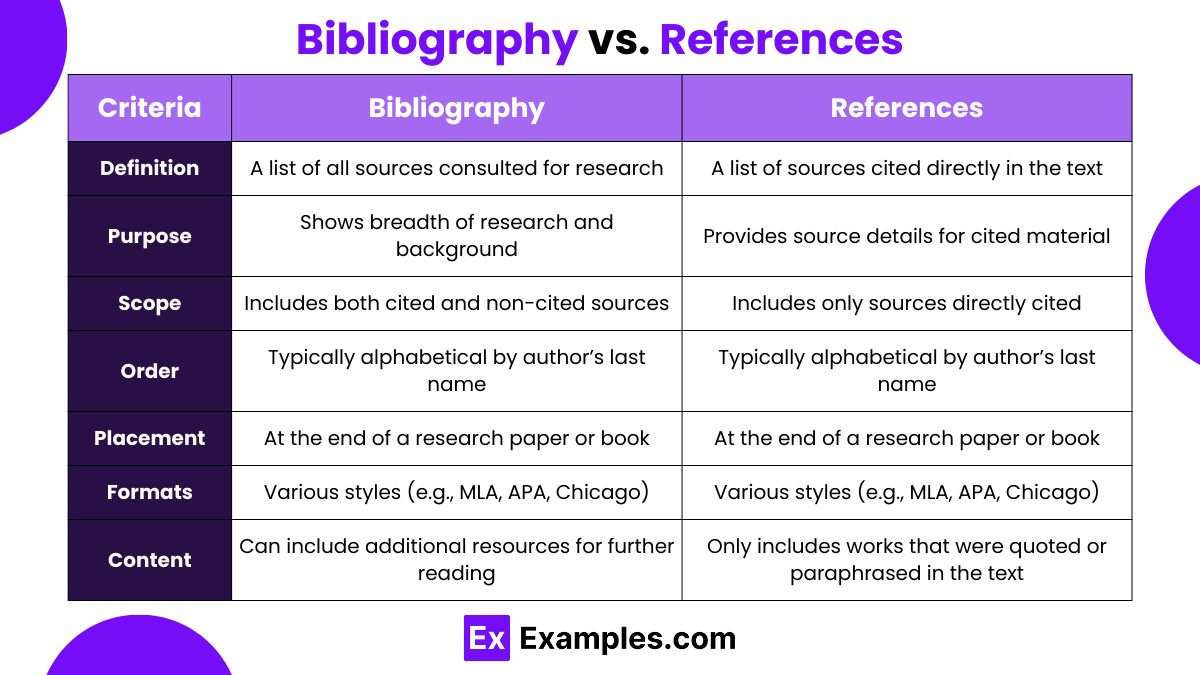
| Aspect | Bibliography | References |
|---|---|---|
| Purpose | Lists all sources consulted for background or further reading | Lists only the sources cited directly in the work |
| Scope | Comprehensive; includes sources not directly cited | Selective; includes only directly cited sources |
| Content | Books, articles, websites, interviews, and other materials | Books, articles, websites, etc., but only those cited |
| Placement | Usually at the end of the work | Also at the end of the work |
| Formats | Varies by citation style (APA, MLA, Chicago, etc.) | Same formats as bibliography but specific to cited sources |
| Usage | Often used in more extensive research, like dissertations | Common in shorter papers, articles, and essays |
| Length | Typically longer due to inclusion of additional sources | Generally shorter as it includes fewer entries |
| Annotations | Can be annotated to provide summaries or evaluations | Rarely annotated unless specified |
| Examples | External reading, background research, etc. | Direct quotes, paraphrases, data, etc. |
| Citation Style | APA: “Bibliography,” MLA: “Works Cited,” Chicago: “Bibliography” | APA: “References,” MLA: “Works Cited,” Chicago: “References” |
| Alphabetization | Alphabetical order by author’s last name | Alphabetical order by author’s last name |
How to Make a Bibliography
- Collect Information: Gather the following details for each source:
- Author(s)
- Title
- Publication date
- Publisher
- Volume and issue numbers (for articles)
- Page numbers
- DOI or URL (for online sources)
- Choose a Citation Style: Use APA, MLA, or Chicago style as required.
- Format Entries: Follow the specific rules for your chosen style.
APA Style Examples
- Book: Smith, J. (2020). Understanding English Literature. Penguin Books.
- Article: Doe, J. (2019). The impact of modern technology on literature. Literary Review, 34(2), 145-158. https://doi.org/10.1234/lr.2019.02.015
MLA Style Examples
- Book: Smith, John. Understanding English Literature. Penguin Books, 2020.
- Article: Doe, Jane. “The Impact of Modern Technology on Literature.” Literary Review, vol. 34, no. 2, 2019, pp. 145-158.
Chicago Style Examples
- Book: Smith, John. Understanding English Literature. New York: Penguin Books, 2020.
- Article: Doe, Jane. “The Impact of Modern Technology on Literature.” Literary Review 34, no. 2 (2019): 145-158. https://doi.org/10.1234/lr.2019.02.015.
- Arrange Entries:
- Alphabetical Order: By the author’s last name.
- Multiple Works by Same Author: List them chronologically.
- Use a Hanging Indent: The first line of each entry is flush left, and subsequent lines are indented.
- Review and Proofread: Ensure accuracy and consistency.
Why is a bibliography important?
It credits sources, avoids plagiarism, and provides evidence, enhancing the credibility and reliability of your academic work.
How do you format a book in a bibliography?
List the author, year, title in italics, and publisher. Follow the rules of your chosen citation style (APA, MLA, Chicago).
What is the difference between a bibliography and a reference list?
A bibliography includes all consulted sources, while a reference list only includes sources directly cited in the text.
How should multiple authors be listed in a bibliography?
List all authors in the order they appear in the source. Use commas to separate names, and an ampersand or “and” before the last author.
How do you cite an online source in a bibliography?
Include the author (or organization), year, title, and URL. Follow specific style guidelines (APA, MLA, Chicago).
What is a hanging indent in a bibliography?
A formatting style where the first line of each entry is flush left, and subsequent lines are indented.
Can I include sources I did not cite in my bibliography?
Yes, in a bibliography, you can include sources you consulted for background information, even if not directly cited.
What information is needed to cite a journal article?
Author(s), year, article title, journal title, volume, issue, page numbers, and DOI if available.
Do different citation styles have different rules?
Yes, APA, MLA, and Chicago styles have unique rules for formatting entries. Follow the specific guidelines for your chosen style.
How often should I update my bibliography?
Update it whenever you add new sources or find more accurate information. Regular updates ensure accuracy and completeness.



